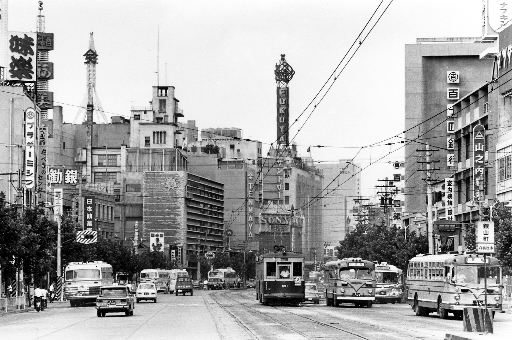Trust: The Memoirs of Akira Yamamoto, Part 20
Oct. 25, 2012
Part 20: Construction of new office building
A-bombing of Hiroshima: Considered in site selection
The site of the Chugoku Shimbun’s office building in Kami-nagarekawa-cho (now Ebisu-cho, Naka Ward), was owned by the Chugoku Company, a general partnership company, and had an area of 690 tsubo. (One tsubo equals 3.3 square meters.) The company had use of a total of 2,400 tsubo of floor space, but the building had been added on to (after the atomic bombing), and the layout was inefficient. The biggest problem was the printing plant.
The number of presses had increased to 11, but there was no basement from which to feed paper. Presses were coupled in pairs and arranged in columns of four. Pillars prevented the use of a conveyor system, so the pressmen had to carry the papers that came off the presses themselves. Plus the plant was difficult to heat, cool and ventilate. Kami-nagarekawa-cho had become such a bustling area that it was difficult to bring rolls of paper into the building and to carry out the morning and evening papers. Around 1964, we began to talk about the relocation of the company’s offices.
During Japan’s high-growth period, with the increase in advertising revenues and the appearance of the fax machine and other technical innovations, the newspaper industry underwent a “qualitative transformation,” according to a history of Japan’s newspaper industry by Akihiko Haruhara and other sources. In 1963 the Chugoku Shimbun was putting out a 16-page morning edition. This was temporarily boosted to 20 pages at the time of the Tokyo Olympics the following year.
A committee was formed to select a location for the new building, and it came up with two candidates: the American Cultural Center (ACC) (which was located in Naka-machi, Naka Ward) and a site in Dobashi-cho across the river from the Municipal Auditorium (which was located in Peace Memorial Park).
The ACC was located on a 730-tsubo lot that was leased from the Prefecture. The lease was to come up for renewal in 1965. The ACC said that the prefecture might be willing to sell the property. The property in Dobashi-cho was surrounded by roads on all four sides, and if the entire block were acquired, it would total 930 tsubo. Kajima Corporation came up with a rough estimate and brought it to us. Starting from the side facing Peace Boulevard, the property belonged to the Hiroshima Prefecture Federation of Livestock Agriculture Cooperative Associations (now the Hiroshima branch of the National Federation of Agricultural Cooperative Associations), the operator of a restaurant in Tate-machi (Naka Ward), private homeowners and an inn.
If we were to build a new office building, we estimated we would need at least 800 million yen, 300 million for the land and another 500 million for the building. The only thing that could serve as collateral for that amount was the land owned by the Chugoku Company. Should we sell the property in Kami-nagarekawa-cho for 900 million yen at 1.5 million yen per tsubo? Or should we use it for collateral? The Chugoku Company had land but not the ability to do business. The newspaper company had assets of only 300 million yen, but it had revenue. A controversy arose over this issue.
I felt the newspaper company should be split off from the general partnership company and should own its own land, buildings and equipment. So of course the general partnership company’s land should be used as collateral or security, but I stressed that the newspaper company should buy land itself.
A 1,200-tsubo lot in Hiratsuka-cho (Naka Ward), which was for the most part owned by Fukuyama Transporting Co., was another strong candidate. Unlike other production plants, newspaper companies can’t use just any location. The proposed site in Dobashi-cho was across from Peace Memorial Park and the Honkawa River. Because Hiroshima would always be associated with the atomic bombing, there were good reasons for the city’s newspaper company to be located there. I talked it over with the president, and we decided to purchase the Dobashi-cho site.
But we got a report that a famous real estate broker had put a deposit down on part of the property. At that time this sort of interference occurred with every large construction project in Hiroshima. For the time being we decided to go ahead and acquire the 400 tsubo owned by the Livestock Agriculture Cooperative and the 200 tsubo owned by the restaurant operator. Yutaka Yoshioka (then assistant manager of the Sales Department) and the top three officials of the cooperative engaged in a lengthy battle of wits and eventually agreed on a price of 320,000 yen per tsubo.
On August 19, 1965, I visited the cooperative’s offices. We signed a provisional agreement, and I put down a deposit. That same day we were told that the Chugoku Shimbun’s A-bombing series had received the Japan Newspaper Publishers and Editors Association Prize, so there was more than one cause for celebration. But we wanted to acquire all the property on that block, so we continued to negotiate.
In 1965 the Chugoku Shimbun published “20 Years after the Bombing,” which consisted of three different series of articles, including full-page articles that ran in the morning edition for 30 days starting on July 8. The paper was awarded the Japan Newspaper Publishers and Editors Association Prize for these series and received the Kikuchi Kan Prize for its campaign to rid the community of organized crime, which was launched in 1963.
(Originally published on October 20, 2012)







